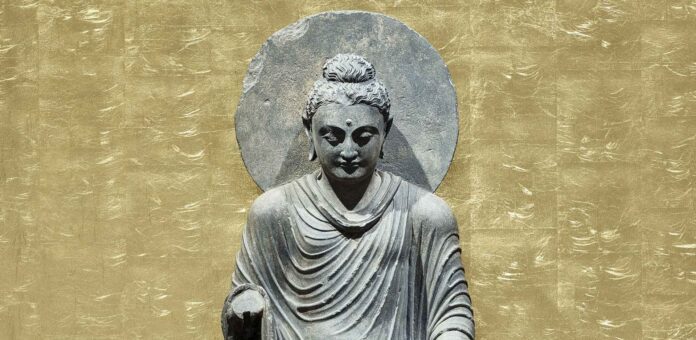Showcasing the world’s civilisations spanning epochs and continents
Around 20,000 exhibits from the world-renowned collections of the Ethnologisches Museum (Ethnological Museum) and the Museum für Asiatische Kunst (Asian Art Museum) of the Staatliche Museen zu Berlin (National Museums in Berlin) showcase the world’s civilizations on more than 16,000 square meters of the Humboldt Forum on the second and third floors. They span epochs and continents ‒ opening up new perspectives on the past and present cultures of Africa, the Americas, Asia, Australia and Oceania.
Ranging from a richly carved meeting house from Palau to audio recordings from all over the world in the Berliner Phonogramm-Archiv: the permanent exhibition of the Ethnologisches Museum focuses on our material and immaterial heritage.
Participating in a Japanese tea ceremony or meditating in front of a statue of Buddha: the Humboldt Forum allows visitors to do all these things thanks to the collections of the Museum für Asiatische Kunst.
20,000 objects on 16,000 square meters
Visitors come away wanting to know more about the collection’s history and about religious questions, contemporary art and the importance of craftsmanship. The exhibition features rituals, performances and perspectives of indigenous communities in order to engage critically with the colonial heritage and the role of Europe.
Africa
The bronzes from the historic kingdom of Benin, which recently became the property of Nigeria, wooden figures and masks from Cameroon, aesthetically outstanding sculptures from the Congo, and clothing decorated with iron and glass beads from Namibia are among the best known and most extraordinary works from Africa in Berlin. However, many of them left the African continent as a result of colonial conquest and rule. The exhibitions of the Ethnologisches Museum’s Africa Collections in the Humboldt Forum raise pressing questions concerning the societies in Africa from which the artifacts originated, the conditions under which they were collected, and the dilemmas in which the relevant parties in Africa found themselves. They demand a cooperative examination of the history of colonialism and its effects right up to the present day.
America
The exhibition area paints a comprehensive picture of historical and contemporary Native American cultures. Highlights include collections from the central and southern Andean region, the impressive Cotzumalhuapa stelae from present-day Guatemala, two totem poles from First Nations in British Columbia and collections from early explorers of the Amazon region. A separate exhibition space is devoted to a diverse collection of ceramics from North, Meso- and South America, as well as collections from the plains and prairies of North America.
Asia
The third floor is dedicated to the art and culture of the largest continent on earth. Collections from the Ethnologisches Museum and the Museum für Asiatische Kunst are brought together here for the first time, creating a dialogue where contemporary art meets centuries-old masterpieces. Experience the art of the Chinese court in a spectacular throne room, watch a Japanese tea ceremony, admire reconstructed Buddhist cave temples painted 1500 years ago, immerse yourself in the world of Indo-Islamic gardens, experience the fascination of the religious rituals surrounding India’s divine sculptures or get to know the fantastic theatre traditions of Southeast Asia and the diversity of Islamic life.
Oceania
The Pacific is the largest ocean in the world and in the vast expanse of the sea, the islands of Oceania seem small and isolated. For the indigenous population, however, the sea was never a barrier. For many, it is part of their identity, even today. Their ancestors traveled great distances and were the first people to discover the Pacific islands. The boats in the Humboldt Forum bear witness to their outstanding navigational and boat-building skills. Houses from Palau, as well as those of the Abelam people of Papua New Guinea, are an additional highlight in the Oceania exhibition area.
Contemporary Art
Contemporary artworks and installations can be found throughout the exhibition areas in the Ethnologisches Museum and the Museum für Asiatische Kunst. Along with António Ole’s Township Wall and imposing artworks by Mariana Castillo Deball, installations addressing the effects of the colonial era in present-day Africa will leave a lasting impression.
A permanent exhibition of the Ethnologisches Museum and the Museum für Asiatische Kunst, Staatliche Museen zu Berlin
Source : Museen zu Berlin











